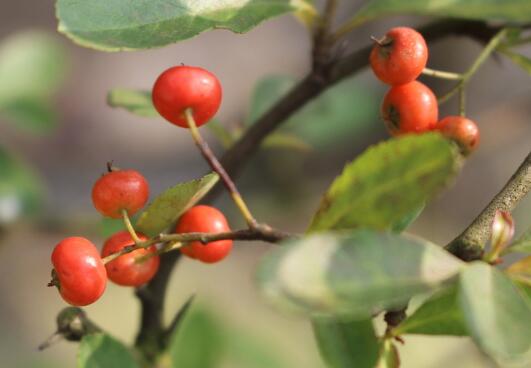How to breed duck foot wood, duck foot wood propagation method/sowing cuttings can be
In evergreen shrubs, duck foot wood is one of the very popular species, in addition to it is very easy to feed, the reproduction of duck foot wood is also very easy, such as sowing, cutting, striping and so on are very practical. Although simple, but also need to follow the correct process to operate, so how to reproduce duck foot wood? Let's take a look at the breeding method of duck foot wood.
How to reproduce duck foot wood

The commonly used methods include sowing, cutting and striping, in which cutting is also divided into water cutting, soil cutting and full light fog, while high-altitude pressing is mainly used. Sowing can be chosen according to their own needs, which is generally used for large-scale reproduction.
First, how to sow the duck foot wood
1. Collect seeds
The fruit period of duck foot wood is planted in December, and the time used to collect seeds is usually in January. after the fruit is collected, the fruit is mixed with fine sand, then the peel and pulp are removed, and the empty seeds inside are washed with clean water. the rest are relatively clean and full seeds, which can be sowed as they are picked, or sand can be stored first and the temperature rises before sowing.
2. Sowing method
After the seed is selected, how to sow the duck foot wood? Using rotten leaf soil or sand as a sand bed, sow the seeds on the sand bed, then cover the soil, the depth is generally 1-2 times the diameter of the seeds, and then appropriate watering to keep the seedbed moist.
Keep the temperature between 20 and 25 degrees so that the seeds will germinate and emerge after 2-3 weeks, and the picture will be ready after another week of management and maintenance. After emergence, it can not be managed in the sun immediately, but needs shade, full light can be given in autumn, heat preservation is needed in winter, and it can be put on the pot after a year of cultivation.
2. High-altitude pressing strip
1. Time. When using striping, how does duck foot wood reproduce? Generally speaking, April to June will be chosen in terms of time.
2. Methods. Select a 2-year-old robust branch from the duck foot plant, peel the branch in a ring, keep the width at about 1 cm, then wrap the wound with wet moss and garden soil, fasten the ends with plastic film, keep the matrix moist, wait for it to take root, cut it short from the connection of the parent plant, and then transplant it.
Third, how to cut duck foot wood
1. Time
Generally choose in spring or autumn, should pay attention to the temperature between 15-25 degrees, in addition to the rainy season, winter and summer should be avoided as far as possible, otherwise it will be more difficult to take root.
2. Methods
Select 2-3-year-old branches from the plant, cut it to keep the length at 15-20 cm, cut off the lower leaves, retain the upper 3 leaves, eliminate the cut and make cuttings.
A. hydroponic cuttage. Pour water into the selected container, insert the cuttings into the prepared container and maintain them in a cool place to ensure that the temperature is between 15 and 25 degrees Celsius. After the cuttings grow 1-2 centimeters of white roots, they can be transplanted and managed normally according to the breeding method of duck foot wood.
B, soil culture cuttage. How do duck feet propagate when using soil culture? Using perlite or garden soil as the substrate, 2/3 of the cuttings are inserted into the substrate, watered through and then maintained in semi-shade. The temperature is controlled at about 20 degrees, which can take root in about 20 days, and then can be transplanted to other places.
How to reproduce duck foot wood the breeding method of duck foot wood
A pot of duck foot wood, it can well absorb nicotine in the air, but also give you a fresh living environment. How does duck foot wood reproduce? Let's take a look at the breeding method of duck foot wood.
The common propagation methods of duck foot wood are sowing propagation and cutting propagation.
First, sowing seeds
After January, the black spherical berries were harvested, mixed with fine sand, rubbed to remove the peel and pulp, and then rinsed with clean water to remove the empty seeds, the clean and full seeds could be obtained, and the seeds could be sowed as soon as they were picked or sown, and the seeds could be seeded in pots or in the ground after the cracks in the seeds were exposed.
Second, cuttage
1. Soil cutting: before changing pots, re-cutting in spring or before sprouting at the beginning of spring, cut 1-year-old branches with a length of 10 cm to 15 cm as cutting material. Remove the lower leaves, keep the top 3-4 leaves, and cut the lower end into a bevel. Drill a small hole in the substrate with a small stick in advance, and insert the 2 stroke 3 of the cuttings into a basin with perlite (or fine screened river sand) as the substrate, single or 3 plants in each basin.
2, water plug: choose mineral water bottle or glass, tall glass bottle, can bottle, rinse clean, as a container. Cut the lower end of the 8 cm long cuttings into a flat mouth, leaving only 3 or 4 leaves at the top. After the container is filled with water, put the cuttings into the container and try to hang it in the water without touching the wall or bottom of the container.
3. Full light fog cutting: plastic film or small glass greenhouse is used to create a small environment with high humidity, so that duck foot wood can propagate rapidly under the condition of high temperature and high humidity. First, lay a layer of brick at the bottom of the cutting slot, and cover it with a layer of sterilized plain sandy soil with a thickness of 30 centimeters. Select the twigs that grew 8 centimeters in that year as cuttings, and the treatment of cuttings is the same as before. Insert the cuttings into the plain sandy soil and spray after the cuttings. Keep room temperature 1525 ℃ and spray water once a day. It can be transplanted after rooting, and the method is the same as before.
4. high branch pressing: from April to June, 2-year-old branches were selected, annular peeling, 1 cm wide, 1 part of wet moss fresh or coniferous soil mixed with 1 part of pastoral soil to cover the wound, and fasten both ends with plastic film. Water it with a syringe every day on a sunny day to maintain the humidity of the substrate. After rooting, it is cut off from the place connected with the mother plant, and then it can be transplanted, the method is the same as before.
For more information, how does duck foot wood breed? The breeding method of Camellia oleifera
Many netizens will ask how to breed duck palm wood. In fact, the main propagation methods of duck palm wood are sowing propagation and cutting propagation. So, next, let's introduce the breeding method of duck foot wood.
Picture: the breeding method of duck foot wood
1. Sowing and breeding of duck foot wood
1. After January, the black spherical berries are harvested, mixed with fine sand, rubbed to remove the peel and pulp, and then rinsed with clean water to remove the empty seeds, the clean and full seeds can be obtained, which can be sowed as soon as they can be picked, or sprouted by sand storage first, and then sowed in pots or in the ground after the seeds are exposed.
two。 Pot sowing with rotten leaf soil or sandy soil, the depth of covering soil is about 1 / 2 times of the seed diameter. The suitable temperature for seed germination is 20: 25 ℃, keep the basin soil or seedling bed moist. Under the suitable temperature, the seedlings can emerge in about 15 to 20 days. Those who germinate and then sow after sand storage can be unearthed after one week under the suitable temperature.
3. Growth is good, shade should be set up in time after seedling emergence, full light should be given in autumn, and plastic film should be covered to prevent cold in winter. As long as the environmental temperature of the local space of the seedling bed is not lower than 5 ℃, it can generally pass the winter safely. Leave the bed to cultivate for one year, then expand the distance and transplant, or use it directly on the pot.
Picture: the breeding method of duck foot wood
II. Cuttage propagation of duck foot wood
1. Combined with basin change, heavy cutting in spring or before sprouting at the beginning of spring, 1-year-old branches with a length of 10 cm to 15 cm were cut as cutting materials. Remove the lower leaves, keep the top 3-4 leaves, and cut the lower end into a bevel.
two。 Drill a small hole in the substrate with a small stick in advance, and insert the 2 stroke 3 of the cuttings into a basin with perlite (or fine screened river sand) as the substrate, single or 3 plants in each basin. Spray water after cutting to keep moist, put it indoors in weak light, spray water once a day on sunny days, depending on specific conditions on rainy days.
3. The cuttings can take root one and a half months after being kept at room temperature for 15 ~ 25 ℃. 15-30 days after rooting, it was transplanted to a basin made of 5 parts of garden soil, 3 parts of humus and 2 parts of fine sand, watered thoroughly, placed in a semi-shady place, and moved to normal light 1 week later.
The above is about the introduction of duck foot wood breeding methods, I hope it can help you!
- Prev

How to propagate Hippophae rhamnoides, the method of propagation / sowing propagation / cutting propagation
Hippophae rhamnoides is a very common flower plant in the world, which is highly ornamental, and there are many people who breed it in our country. With more people raising it, people are more concerned about its reproduction. So how do firethorns reproduce? What are the breeding methods of Pyracantha?
- Next

How to propagate Cymbidium grandiflora? two propagation methods / ramets of Cymbidium are the most practical.
As an orchid variety cultivated by artificial hybridization, Cymbidium is very effective, simply speaking, it is very ornamental. It is not only pleasing to the eye, but also can purify the air and beautify the home. If such plants are naturally propagated in large numbers, how can Cymbidium reproduce? Here are two propagation methods of Cymbidium.
Related
- Fuxing push coffee new agricultural production and marketing class: lack of small-scale processing plants
- Jujube rice field leisure farm deep ploughing Yilan for five years to create a space for organic food and play
- Nongyu Farm-A trial of organic papaya for brave women with advanced technology
- Four points for attention in the prevention and control of diseases and insect pests of edible fungi
- How to add nutrient solution to Edible Fungi
- Is there any good way to control edible fungus mites?
- Open Inoculation Technology of Edible Fungi
- Is there any clever way to use fertilizer for edible fungus in winter?
- What agents are used to kill the pathogens of edible fungi in the mushroom shed?
- Rapid drying of Edible Fungi

